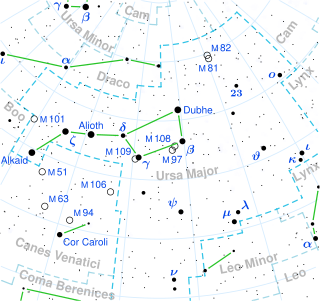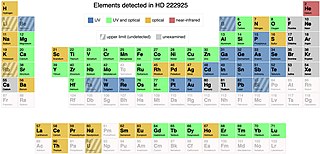Related Research Articles

HE0107-5240 is an extremely metal-poor Population II star, located roughly 36000 light-years away from Earth. It is one of the most metal-poor stars known in our Galaxy, with a metallicity [Fe/H] = −5.2±0.2; i.e. it has just 1/160000 of the metal that the Sun has. Because of its very low metallicity, it is believed to be one of the earliest Population II stars to have formed. If so, then it is also very old, with an age of roughly 13 billion years. Because the star is not completely metal-free, it does not belong to the first generation of stars. These stars converted the pristine hydrogen, helium, and lithium formed by the Big Bang into heavier elements, such as carbon, oxygen, and metals.
BPS CS31082-0001, named Cayrel's Star, is an old Population II star located in a distance of 2.1 kpc in the galactic halo. It belongs to the class of ultra-metal-poor stars, specifically the very rare subclass of neutron-capture enhanced stars. It was discovered by Tim C. Beers and collaborators with the Curtis Schmidt telescope at the Cerro Tololo Inter-American Observatory in Chile and analyzed by Roger Cayrel and collaborators. They used the Very Large Telescope (VLT) at the European Southern Observatory in Paranal, Chile for high-resolution optical spectroscopy to determine elemental abundances. The thorium-232 to uranium-238 ratio was used to determine the age. It is estimated to be about 12.5 billion years old, making it one of the oldest known.

Groombridge 1830 is a star in the constellation Ursa Major.

HE 1327-2326, discovered in 2005 by Anna Frebel and collaborators, was the star with the lowest known iron abundance until SMSS J031300.36−670839.3 was discovered. The star is a member of Population II stars, with a solar-standardised iron to hydrogen index [Fe/H], or metallicity, of −5.4±0.2. The scale being logarithmic, this number indicates that its iron content is about 1/250000 that of the Earth's sun. However, it has a carbon abundance of roughly one-tenth solar, and it is not known how these two abundances can have been produced/exist simultaneously. Discovered by the Hamburg/ESO survey for metal-poor stars, it was probably formed during an age of the universe when the metal content was much lower. It has been speculated that this star is part of the second generation, born out of the gas clouds which were imbued with elements such as carbon by the primordial Population III stars.

Mu Cassiopeiae, Latinized from μ Cassiopeiae, is a binary star system in the constellation Cassiopeia. This system shares the name Marfak with Theta Cassiopeiae, and the name was from Al Marfik or Al Mirfaq (المرفق), meaning "the elbow". It is dimly visible to the naked eye as a point of light with an apparent visual magnitude of 5.16. The system is located at a distance of 25 light years from the Sun based on parallax, and is moving closer with a high radial velocity of −98 km/s. This star will move into the constellation Perseus around 5200 AD.
BD+17°3248 is an old Population II star located at a distance of roughly 968 light-years in the Galactic Halo. It belongs to the class of ultra-metal-poor stars, especially the very rare subclass of neutron-capture (r-process) enhanced stars.

Gamma1 Caeli, Latinized from γ1 Caeli, is a double star in the constellation Caelum. It consists of a K-type giant, and a G-type subgiant.

HE 1523-0901 is the designation given to a red giant star in the Milky Way galaxy approximately 9,900 light years from Earth. It is thought to be a second generation, Population II, or metal-poor, star ([Fe/H] = −2.95). The star was found in the sample of bright metal-poor halo stars from the Hamburg/ESO Survey by Anna Frebel and collaborators. The group's research was published in the May 10, 2007 issue of The Astrophysical Journal.
HD 122563 is an extremely metal-poor red giant star, and the brightest metal-poor star in the sky. Its low heavy element content was first recognized by spectroscopic analysis in 1963. For more than twenty years it was the most metal-poor star known, being more metal-poor than any known globular cluster, and it is the most accessible example of an extreme population II or Halo star.

HD 165634 is a star in the southern constellation of Sagittarius. It has a yellow hue and is faintly visible to the naked eye with apparent visual magnitude of 4.56. The star is located at a distance of approximately 339 light years from the Sun based on parallax, but is drifting closer with a radial velocity of −5 km/s. It has an absolute magnitude of −0.53.

HD 140283 is a metal-poor subgiant star about 200 light years away from the Earth in the constellation Libra, near the boundary with Ophiuchus in the Milky Way Galaxy. Its apparent magnitude is 7.205, so it can be seen with binoculars. It is one of the oldest stars known.
HD 126053 is the Henry Draper Catalogue designation for a star in the equatorial constellation of Virgo. It has an apparent magnitude of 6.25, which means it is faintly visible to the naked eye. According to the Bortle scale, it requires dark suburban or rural skies to view. Parallax measurements made by the Hipparcos spacecraft provide an estimated distance of 57 light years to this star. It is drifting closer with a heliocentric radial velocity of −19.2 km/s.

Timothy C. Beers is an American astrophysicist. Beers teaches at the University of Notre Dame in the Department of Physics (2014–present), where he holds the Notre Dame Chair in Astrophysics. He is a co-founder of the Physics Frontier Center Joint Institute for Nuclear Astrophysics – Center for the Evolution of the Elements. Prior to coming to Notre Dame, Beers was Director of Kitt Peak National Observatory (2011-2014), and for 25 years was a professor in the Department of Physics and Astronomy at Michigan State University (1986-2011), retiring from that position as University Distinguished Professor.
HD 2454 is a probable binary star system in the zodiac constellation of Pisces. With an apparent visual magnitude of 6.04, it is near the lower limit of visibility to the naked eye under good seeing conditions. An annual parallax shift of 26.3 mas as measured from Earth's orbit provides a distance estimate of 124 light years. It has a relatively high proper motion, traversing the celestial sphere at a rate of 0.208 arcseconds per year, and is moving closer to the Sun with a heliocentric radial velocity of −10 km/s.
HAT-P-15 is a G-type main-sequence star about 630 light-years away. The star is older than Sun yet has a concentration of heavy elements roughly 190% of solar abundance. The star has no noticeable starspot activity.
HD 64307, also known as HR 3075, is a solitary, orange hued star located in the northern circumpolar constellation Camelopardalis. It has an apparent magnitude of 5.35, allowing it to be faintly seen with the naked eye. Based on parallax measurements from the Gaia spacecraft, The object is estimated to be 690 light years distant. It appears to be receding from the Sun, having a heliocentric radial velocity of 34 km/s.

HD 222925 is a horizontal branch star about 1,470 light years away in the southern constellation Tucana. It is magnitude 9, far below naked-eye visibility. It is an Ap star, a type of chemically peculiar star with an over-abundance of certain metals in its spectrum.
James Wellington Truran Jr. was an American physicist, known for his research in nuclear astrophysics.
HE 1219-0312 is an extremely metal-poor star in the constellation Virgo, The star is located at around 41,400 light years away from earth.
References
- 1 2 3 4 5 Brown, A. G. A.; et al. (Gaia collaboration) (August 2018). "Gaia Data Release 2: Summary of the contents and survey properties". Astronomy & Astrophysics . 616. A1. arXiv: 1804.09365 . Bibcode: 2018A&A...616A...1G . doi: 10.1051/0004-6361/201833051 . Gaia DR2 record for this source at VizieR.
- 1 2 3 4 Roederer, Ian U.; et al. (June 2014). "A Search for Stars of Very Low Metal Abundance. VI. Detailed Abundances of 313 Metal-poor Stars". The Astronomical Journal. 147 (6): 57. arXiv: 1403.6853 . Bibcode:2014AJ....147..136R. doi:10.1088/0004-6256/147/6/136. S2CID 119249291. 136.
- 1 2 3 Norris, John E.; et al. (October 1997). "Extremely Metal-poor Stars. IV. The Carbon-rich Objects". The Astrophysical Journal. 488 (1): 350–363. Bibcode:1997ApJ...488..350N. doi:10.1086/304695. S2CID 121307016.
- ↑ Beers, Timothy C.; Preston, George W.; Shectman, Stephen A. (1992). "A Search for Stars of Very Low Metal Abundance. II". The Astronomical Journal. 103: 1987. Bibcode:1992AJ....103.1987B. doi:10.1086/116207. S2CID 121564385.
- ↑ Anders, F.; Khalatyan, A.; Chiappini, C.; Queiroz, A. B.; Santiago, B. X.; Jordi, C.; Girardi, L.; Brown, A. G. A.; Matijevic, G.; Monari, G.; Cantat-Gaudin, T. (2019-08-01). "Photo-astrometric distances, extinctions, and astrophysical parameters for Gaia DR2 stars brighter than G = 18". Astronomy and Astrophysics. 628: A94. arXiv: 1904.11302 . Bibcode:2019A&A...628A..94A. doi: 10.1051/0004-6361/201935765 . ISSN 0004-6361.
- ↑ Stassun, Keivan G.; Oelkers, Ryan J.; Paegert, Martin; Torres, Guillermo; Pepper, Joshua; De Lee, Nathan; Collins, Kevin; Latham, David W.; Muirhead, Philip S.; Chittidi, Jay; Rojas-Ayala, Bárbara (2019-10-01). "The Revised TESS Input Catalog and Candidate Target List". The Astronomical Journal. 158 (4): 138. arXiv: 1905.10694 . Bibcode:2019AJ....158..138S. doi: 10.3847/1538-3881/ab3467 . hdl: 1721.1/124721 . ISSN 0004-6256. S2CID 166227927.
- ↑ "BPS CS 22892-0052". SIMBAD . Centre de données astronomiques de Strasbourg . Retrieved 2021-03-29.